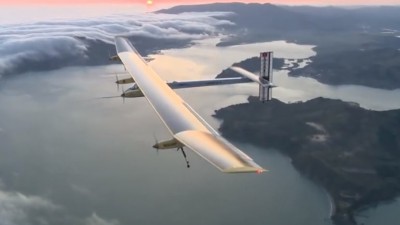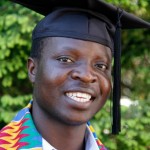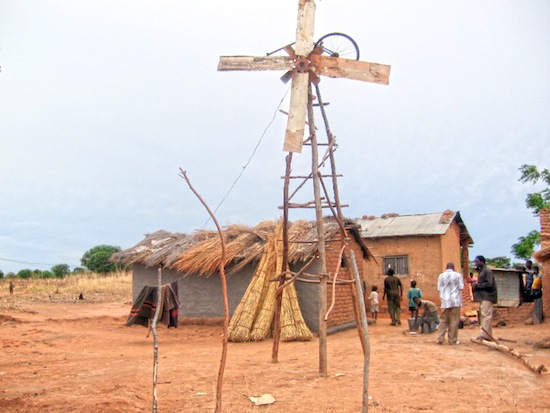We should never give up our struggle for clean energy; that’s the lesson from opposite ends of the technology spectrum. [17 March 2015 | Peter Boyer]
Life’s full of surprises. Just when it seems there’s no hope for humanity’s tangled mess, a couple of wonderful stories turn up to show why we should never stop trying.
One of them is about a propeller-driven flying machine with a payload of just one man and his food, a stack of batteries and an emergency life-raft. Nothing special, you’d think.
But this aircraft challenges everything we’ve ever thought about energy. A week ago Solar Impulse 2, the creation of two Swiss men, explorer Bertrand Piccard and engineer-pilot Andre Borschberg, took off on a long journey fuelled entirely by sunlight.
Solar Impulse 2 is on a months-long circumnavigation of the globe. Starting from Abu Dhabi, it’s already flown thousands of kilometres across the Arabian Sea and India. Barring misadventure, it will continue via Myanmar and China, across the Pacific to the US, then to Abu Dhabi via Europe.
It weighs about the same as a Mercedes saloon and its speed is modest to say the least: maximum 140 km/h and cruising speeds of 90 km/h in the day-time and 60 km/h at night.
Here’s where it gets interesting. The upper side of its huge wings, rivalling those of an Airbus 380, are covered in 250 square metres of 17,248 advanced solar cells with a combined output of 45,000 watts, embedded in an ultra-thin lightweight film developed especially for the aircraft.
With super-efficient foam insulation around the cabin, the aircraft flies as high as 12,000 metres during the day to soak up as much solar power as possible. After sundown it descends slowly while drawing on 164,580 watt-hours of surplus power stored in a state-of-the-art battery system.
It’s not hard to characterise this project as an extravagance. This very expensive aircraft is no sure pointer to the future of aviation. But its symbolic value as a vehicle of hope is priceless.
Another vehicle of hope is to be found in a gem of a book given to me by a friend who shares my interest in clean energy.
Wimbe is a tiny village serving a subsistence farming community in the small southern African nation of Malawi. Its favourite son is an exceptional young man named William Kamkwamba.
Like most Malawians, Kamkwamba was born into a dirt-poor family, living on what a small land-holding could yield and depending heavily on the annual wet-dry weather cycle.
The failure of the 2000 wet season started a devastating famine across the country, which took the lives of many people in Kamkwamba’s own village. His early adolescence was dominated by desperate hunger in which corn husks and pumpkin leaves were often all there was to eat.
Hunger of another kind was to change his life. Kamkwamba yearned to know how things work and how technology might make life better.
It wasn’t easy. He had to drop out from school for years because his parents couldn’t afford to pay his fees. He found a way round that by teaching himself to read, borrowing books from the village library. (Never say that libraries are a luxury we can’t afford.)
Physics fascinated him. A book about wind turbines inspired him to try building one for his family and village. The story of how he did this is told in The boy who harnessed the wind, a book ghost-written by US journalist Bryan Mealer.
Guided by a textbook from his library called Understanding Physics, Kamkwamba put together a room full of bits and pieces scrounged from disused vehicles and other items around his village: small lengths of copper wire, a fan from a tractor, blades from a PVC pipe, pulleys and belts.
He persuaded his father to give up his treasured bicycle for parts, and a passing cyclist sold him a dynamo. He applied physics principles from the textbook to build a transformer to power different devices, and a circuit-breaker to prevent an electrical spark from causing a house fire. The tower itself was built from spindly lengths of locally-grown Tasmanian bluegum!
The story of Wimbe’s wind-tower and its “school dropout with a streak of genius” found its way into Malawi’s Daily Times. A US activist read about him and took him in hand, securing funding to complete his education, a generosity which Kamkwamba repaid in spades. He successfully completed a secondary education and a couple of years ago graduated from a US college as an engineer.
Now back his home village, he’s built school classrooms, a bio-digester, solar plants and other windmills. William is not alone; in Malawi and across Africa local champions are now powering their communities with solar and wind technologies. We have much to learn from them.
William’s rickety windmill and the sleek, slickly-promoted Solar Impulse 2 are at opposite ends of the technology and economic spectrum. But in its own way, each is an inspiration for careworn humanity to stay the course.



